 |
Introduction Site Map Email: jja@nac.net |

"I don't know. It is Odin's disk and it has only one side."
— J. L. Borges, The Disk.


Thursday, August 5th, 2004
This time around, I'm going to start explaining in detail why my aliens have feet and legs that are, in general function, similar to those of mammals on Earth. What's wrong with other forms of locomotion? The short answer is that, if you want to move quickly and nimbly, the leg structure of certain mammals (such as the cheetah and the horse) are among the best possible solutions, from an engineering standpoint. But just saying this doesn't show why, so I'm going to eliminate some other possibilities first. This means that certain things that I had been saying would appear in the 'next entry' will be pushed down the stack a bit, but I haven't forgotten them and will get to them in due course.
To start with, some assumptions (there are always assumptions):
- We're dealing with living creatures that need to propel themselves quickly over a broad flat material surface (the ground), to which they are held by a force (gravity)1.
- The animals are made out of flesh and bone, and not, say, industrial grade titanium, so that solutions which include nozzles and storage tanks of rocket fuel are not permitted.
- The basic mechanism for moving is as simple as possible, on the premise that natural selection would start with the easy ways first. In the context of this discussion, I'm limiting the possibilities to what are known as the simple machines, mechanisms that exemplify basic principles in physics, and which are usually classified as follows: wheel, lever, inclined plane, wedge, screw and pulley.
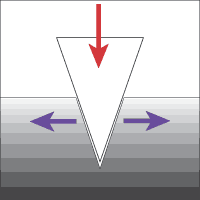 I'll
start with the wedge. For those rusty in basic
mechanics, a wedge is a way to redirect a force that is moving., say,
forwards, and make it go laterally (side to side). The
illustration shows the main force as a red arrow and the resultant
force as blue arrows.
I'll
start with the wedge. For those rusty in basic
mechanics, a wedge is a way to redirect a force that is moving., say,
forwards, and make it go laterally (side to side). The
illustration shows the main force as a red arrow and the resultant
force as blue arrows.The wedge works in reverse as well; flip the blue arrows and you flip the red arrow, too. This is analogous to what happens when you squeeze a tube of toothpaste...
The wedge finds application in the real world in log splitters, the prows of ships, cleavers, teeth, doorstops and shims. But is it possible to apply the principle of the wedge directly to an animal's locomotion?
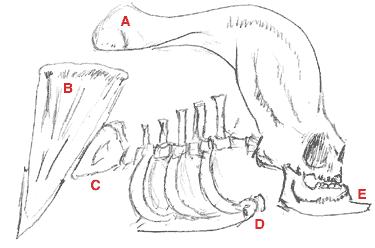 I think
the answer is no, but that didn't stop me from
imagining what it might be like, anyway. The illustration at right
shows the skeleton of a (very) hypothetical animal. It uses the bony
club at A to apply force to
the horn-tipped wedge bone, at B.
As the wedge is driven into the ground, it applies force to the ground
behind the animal, and also to the animal's pelvis, C, causing forward movement. The
breastbone, D, forms a
horn-edged double runner to ease friction, and the horny projection on
the jaw at E lets the animal
steer.
I think
the answer is no, but that didn't stop me from
imagining what it might be like, anyway. The illustration at right
shows the skeleton of a (very) hypothetical animal. It uses the bony
club at A to apply force to
the horn-tipped wedge bone, at B.
As the wedge is driven into the ground, it applies force to the ground
behind the animal, and also to the animal's pelvis, C, causing forward movement. The
breastbone, D, forms a
horn-edged double runner to ease friction, and the horny projection on
the jaw at E lets the animal
steer.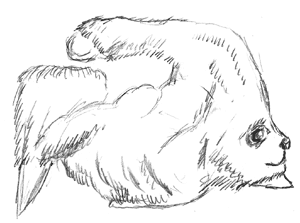 To
the left is how
the critter might look with skin and muscle. It has short fur, and the
top of the wedge is covered with matted fur and a calloused pad from
repeated striking.
To
the left is how
the critter might look with skin and muscle. It has short fur, and the
top of the wedge is covered with matted fur and a calloused pad from
repeated striking.Visible are the muscles that attach to the pelvis and the wedge so that the animal can pull the wedge back up from the ground, advance the point a few inches, and get ready for another round of smacking. There are also powerful muscles on the back and neck, supported by the dorsal spines, that let it apply maximum force to the bony club. Note that the animal tosses its head back to apply pressure to the wedge, and at the same time lowers its jaw so that its mandibular rudder can contact the ground and permit turning.
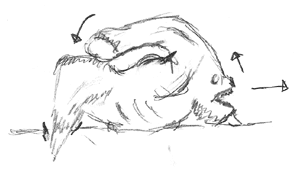
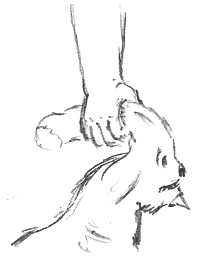 It
should be obvious that this is a very slow and clumsy way to get
about, and any animal employing this method would be readily
outmaneuvered by those with more evolutionary initiative. One can
imagine them developing peacefully on an isolated island, only to face
fatal selective pressure once a land bridge arises. Jane or Joe
Cavedweller, for instance, would find the bony club to be a convenient
carrying handle, and the poor beast would be completely helpless once
lifted into the air in this way...
It
should be obvious that this is a very slow and clumsy way to get
about, and any animal employing this method would be readily
outmaneuvered by those with more evolutionary initiative. One can
imagine them developing peacefully on an isolated island, only to face
fatal selective pressure once a land bridge arises. Jane or Joe
Cavedweller, for instance, would find the bony club to be a convenient
carrying handle, and the poor beast would be completely helpless once
lifted into the air in this way...So it seems that the wedge as a form of locomotion would be a literal pain in the ass. (If you can come up with a plausible method, or an actual occurrence in the real world of an animal that gets about on the wedge principle, please email me.)
I'll continue in the next entry with another animal based on a simple machine...
1 For an informative change in perspective, go to the beach and lie on your side, facing the ocean. Imagine the ocean as a wall of water taller than a thousand skyscrapers, being pressed against the side of an immense sphere. What you're imagining is actually true — and you yourself are being held to the side of this sphere by the same invisible force that keeps all that water where it is.



pageatatime.com is hosted by net access corporation - www.nac.net